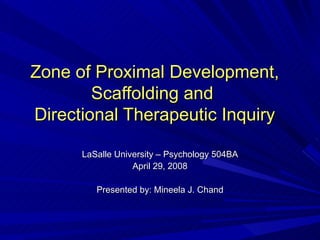
ZPD And Therapy
- 1. Zone of Proximal Development, Scaffolding and Directional Therapeutic Inquiry LaSalle University – Psychology 504BA April 29, 2008 Presented by: Mineela J. Chand
- 2. What is the problem...? Narrative (a la Michael White & David Epston) is a powerful way of working with people but not empirically supported...like so many other clinical practice theories... What is the “zone of proximal development” and “scaffolding”? Is there a way to intentionally direct conversation with a client using therapeutic inquiry?
- 3. Thesis Statement Provide understanding of zone of proximal development (ZPD) and scaffolding Brief review of literature Attempt to connect ZPD and scaffolding to Narrative practice Implications for psychotherapy and therapist education
- 4. Zone of Proximal Development Vygotsky defined the zone of proximal development as... “the distance between the actual developmental level as determined by independent problem solving and the level of potential development as determined through problem solving under adult guidance or in collaboration with more capable peers” (Vygotsky in Burkhalter, 1994, p. 5) Therefore, acquisition of knowledge/skills occurs within a social context.
- 5. In other words.... What is possible to know (upper limit) What is known (lower limit)
- 6. Scaffolding Scaffolding is the process by which a teacher guides a child in incremental successive cognitive steps toward the upper limit of the zone in collaboration with the child to reach the target goal or skill (Belmont, 1989) using different strategies (for example questioning and feedback). Scaffolding can be likened to the structural scaffolding used in the construction of a building before it is left to stand independently.
- 7. In therapy.... What is possible to know (upper limit) – new possibilities, knowledge of self and problem/life and skills of living; personal agency Therapeutic inquiry – it’s all about the questions therapists ask.... The questions create a chain of association that leads to more complex ways of thinking that involves establishing bonds and relationships between each connected piece in manageable increments. What is known and familiar (lower limit) – “problem saturated stories”
- 8. White’s “Scaffolding Conversations Map” What is possible to know (upper limit) – new possibilities, knowledge of self and problem/life and skills of living; personal agency Very High Plans for action High Abstraction of learnings & realizations Reflections on chain of association, Medium High learnings, & realizations Medium Unique outcome taken into chain of association Low Characterizing the unique outcome What is known and familiar (lower limit) – “problem saturated stories”
- 9. An example... bio-mother bio-father therapist Child – “Brandon” step-mother best friend step-father teacher
- 10. In practice... stand against “lying” and stand with “truth-telling” Very High Plans for action (co- Levels of distancing constructed solutions) tasks “I don’t have to play with lying when it asks High me to come out and play”, “I can say ‘no” and do things that don’t get me in trouble” “wow! I can do it!”, “it feels good not to get into trouble”, Medium High “see, I don’t always lie”, “I can do hard things that are right” Medium “kept my privileges”, “avoided going to the principal’s office”, “didn’t get mom and dad and my teachers mad at me”, “didn’t get into trouble” “walking away from lying”, “telling the truth”, “hard but I did it” Low “figuring ‘who needs it’”, “not losing it”, “keeping one’s mind” “lying gets me into trouble”, “I can’t not lie”, “it’s not my fault”, “I am a liar”
- 11. ZPD/Scaffolding Strategies in Therapeutic Context Therapeutic alliance is collaborative, reciprocal, and dynamic (Vare, 1993) Determine, with the client, the lower and upper limits of the ZPD (Seng, 1997); give words to/name the problem and the goal Begin at the lower limit; starting somewhere else will not lead to sustained change or generalizability (Belmont, 1998); starting at an upper limit will require reminders and starting in the middle will lead to an inability to generalize Aim for a quality of relationship exemplified by genuine respect and care, bringing a human(e) element into the process Share responsibility with the client – you have yours and they have theirs! – Theirs – to work just as/harder than you – Yours – to scaffold appropriately Check in with the client occasionally to make sure you are talking about what is most vital to the client (Ge & Land, 2001)
- 12. ZPD/Scaffolding Strategies in Therapeutic Context Set a positive emotional tone conveying warmth, respect, & listening attitude (Shuster, 2000) Build shared understanding by repeating client’s own words, restating, & seeking clarity Extend understanding by asking “meaningful, open-ended questions to stimulate, provoke, expand thinking, and voiced limited conversation to a sense of a ‘right’ answer” (p. 291) Questions are powerful (Ge & Land, 2001); they can: – Direct attention to information which may not have been previously considered – Help represent the problem – Make connections between resources and constraints – Link to solutions – Help think about alternative solutions and their viability – Organize thinking – Break down the problem into small steps